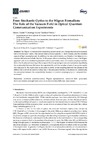Identificador persistente para citar o vincular este elemento:
https://accedacris.ulpgc.es/jspui/handle/10553/69319
| Campo DC | Valor | idioma |
|---|---|---|
| dc.contributor.author | Casado, Alberto | - |
| dc.contributor.author | Guerra Guillén, Santiago Ramón | - |
| dc.contributor.author | Plácido Suárez, José | - |
| dc.date.accessioned | 2020-01-24T10:18:57Z | - |
| dc.date.available | 2020-01-24T10:18:57Z | - |
| dc.date.issued | 2019 | - |
| dc.identifier.issn | 2218-2004 | - |
| dc.identifier.other | WoS | - |
| dc.identifier.uri | https://accedacris.ulpgc.es/handle/10553/69319 | - |
| dc.description.abstract | The Wigner formalism in the Heisenberg picture constitutes a bridge that connects Quantum Optics to Stochastic Optics. The vacuum field appears explicitly in the formalism, and the wavelike aspects of light are emphasised. In addition, the zeropoint intensity as a threshold for detection is a common denominator in both theories. In this paper, after summarising the basic rules of the Wigner approach and its application to parametric down-conversion, some new results are presented that delve into the physical meaning of the zeropoint field in optical quantum communication. Specifically, the relationship between Bell-state distinguishability and the number of sets of zeropoint modes that take part in the experiment is analysed in terms of the coupling between the phases of the different fields involved and the subtraction of the zeropoint intensity at the detectors. Additionally, the connection between the compatibility theorem in quantum cryptography and zeropoint field is stressed. | - |
| dc.language | eng | - |
| dc.relation.ispartof | Atoms | - |
| dc.source | Atoms [ISSN 2218-2004], v 7 (3), 76, (Agosto 2019) | - |
| dc.subject | 3311 tecnología de la instrumentación | - |
| dc.subject.other | Parametric Down-Conversion | - |
| dc.subject.other | Representation | - |
| dc.subject.other | State | - |
| dc.subject.other | Downconversion | - |
| dc.subject.other | Fluctuations | - |
| dc.subject.other | Entanglement | - |
| dc.subject.other | Spectrum | - |
| dc.title | From Stochastic Optics to the Wigner Formalism: The Role of the Vacuum Field in Optical Quantum Communication Experiments | - |
| dc.type | info:eu-repo/semantics/Article | - |
| dc.type | Article | - |
| dc.identifier.doi | 10.3390/atoms7030076 | - |
| dc.identifier.isi | 000487984900029 | - |
| dc.identifier.eissn | 2218-2004 | - |
| dc.identifier.issue | 3 | - |
| dc.relation.volume | 7 | - |
| dc.investigacion | Ingeniería y Arquitectura | - |
| dc.type2 | Artículo | - |
| dc.contributor.daisngid | 3108313 | - |
| dc.contributor.daisngid | 4097171 | - |
| dc.contributor.daisngid | 4848449 | - |
| dc.description.notas | This article belongs to the Special Issue Stochastic Electrodynamics | - |
| dc.description.numberofpages | 22 | - |
| dc.utils.revision | Sí | - |
| dc.contributor.wosstandard | WOS:Casado, A | - |
| dc.contributor.wosstandard | WOS:Guerra, S | - |
| dc.contributor.wosstandard | WOS:Placido, J | - |
| dc.date.coverdate | Agosto 2019 | - |
| dc.identifier.ulpgc | Sí | - |
| dc.description.sjr | 0,376 | |
| dc.description.sjrq | Q3 | |
| dc.description.esci | ESCI | |
| item.grantfulltext | open | - |
| item.fulltext | Con texto completo | - |
| crisitem.author.dept | GIR IDeTIC: División de Ingeniería Térmica e Instrumentación | - |
| crisitem.author.dept | IU para el Desarrollo Tecnológico y la Innovación | - |
| crisitem.author.dept | Departamento de Didácticas Específicas | - |
| crisitem.author.orcid | 0000-0002-9918-297X | - |
| crisitem.author.orcid | 0000-0001-6801-735X | - |
| crisitem.author.parentorg | IU para el Desarrollo Tecnológico y la Innovación | - |
| crisitem.author.fullName | Guerra Guillén, Santiago Ramón | - |
| crisitem.author.fullName | Plácido Suarez, José | - |
| Colección: | Artículos | |
Vista resumida
Citas de WEB OF SCIENCETM
Citations
5
actualizado el 08-jun-2025
Visitas
168
actualizado el 12-jul-2025
Descargas
109
actualizado el 12-jul-2025
Google ScholarTM
Verifica
Altmetric
Comparte
Exporta metadatos
Los elementos en ULPGC accedaCRIS están protegidos por derechos de autor con todos los derechos reservados, a menos que se indique lo contrario.
